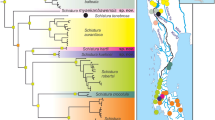Abstract
THE systematic position of the genus Sarcotaces, according to Caiman1, is quite obscure, for as a result of the extreme degeneration shown by the parasite most of the characteristic features have disappeared. Although S. arcticus is not infrequent in the blue ling, Molva abyssorum, appearing as dark oval-shaped cysts lying among the myotomes of the lateral line, it has only been very briefly referred to by Collett2 and Hjort3, who suggested that it was a Cirripede. Two other species have been recorded, S. verrucosus by Olsson (1873)5 from Acanthurus in the West Indies, and S. pacificus from Antennarius at Misaki, Japan, by Komai4, who suggested that it belonged to the Copepoda.
This is a preview of subscription content, access via your institution
Access options
Subscribe to this journal
Receive 51 print issues and online access
$199.00 per year
only $3.90 per issue
Buy this article
- Purchase on Springer Link
- Instant access to full article PDF
Prices may be subject to local taxes which are calculated during checkout
Similar content being viewed by others
References
Calman, W. T., "A Treatise on Zoology", Part 7, Appendiculata (A. and C. Black, London, 1909).
Collett, Forh, ved de skand., 11 Møde i Kjøbenhavn (1874).
Hjort, J., Skr. Vidensk. Selsk., Christ., 1 Math. nat. Kl., No. 2 (1895).
Komai, T., Mem. Coll. Sci. Kyoto., B, 1, No. 3 (1924).
Olsson, quoted by Hjort, loc. cit.
Author information
Authors and Affiliations
Rights and permissions
About this article
Cite this article
AITKEN, A. An Undescribed Stage of Sarcotaces. Nature 150, 180–181 (1942). https://doi.org/10.1038/150180b0
Issue Date:
DOI: https://doi.org/10.1038/150180b0
Comments
By submitting a comment you agree to abide by our Terms and Community Guidelines. If you find something abusive or that does not comply with our terms or guidelines please flag it as inappropriate.



